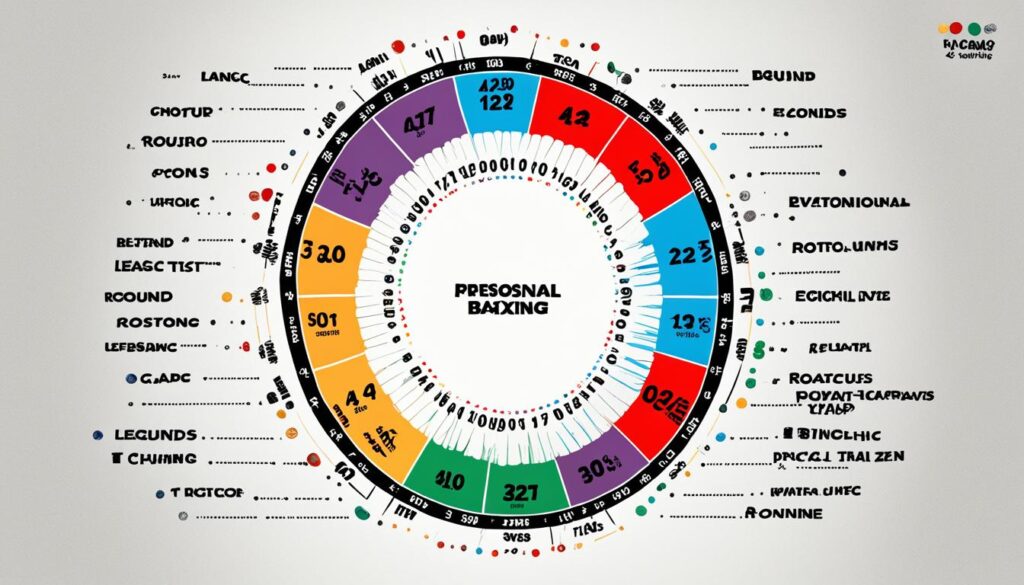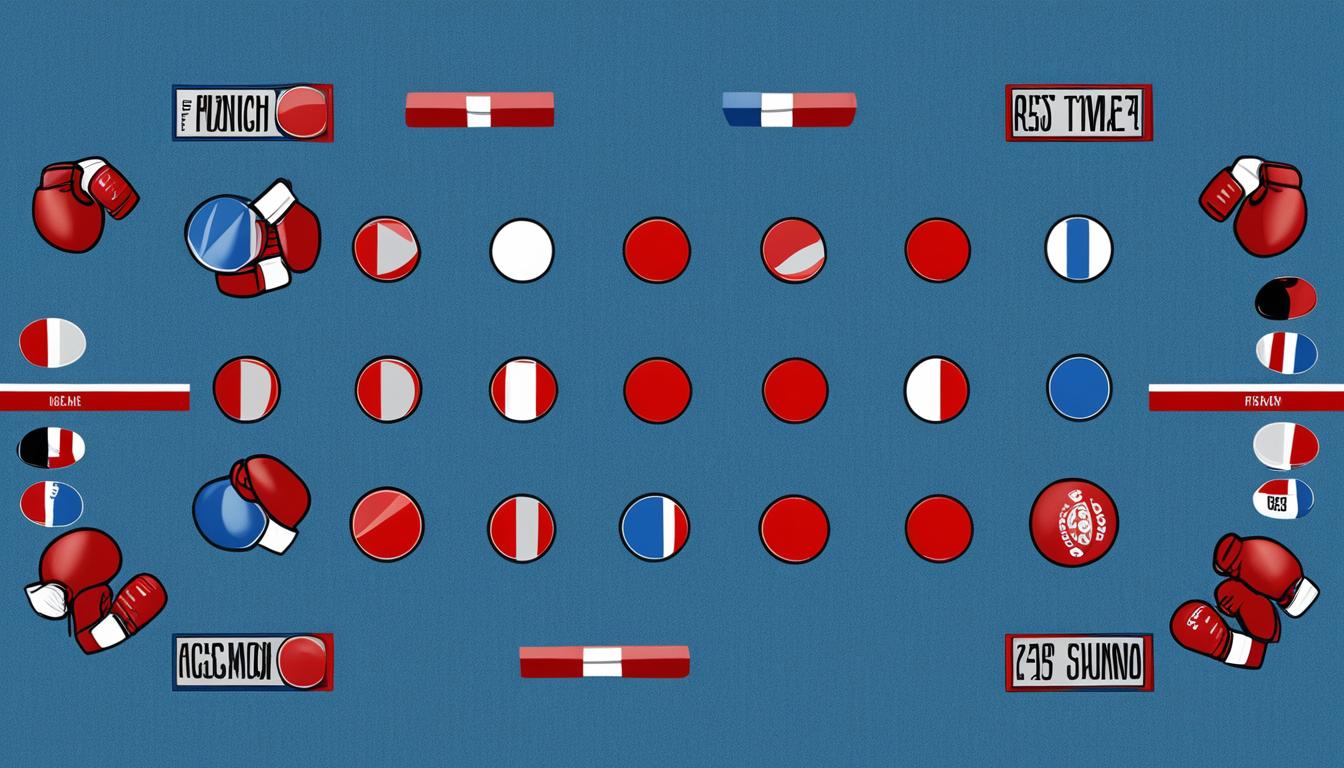Rounds are a fundamental aspect of professional boxing matches. They determine the duration and structure of a fight, as well as the number of opportunities for boxers to showcase their skills and strategies. Understanding how many rounds are in a boxing match is important for both boxing enthusiasts and newcomers to the sport.
Key Takeaways:
- Boxing matches are organized into rounds, which determine the duration and structure of the fight.
- The number of rounds in a boxing match can vary depending on the type of fight.
- Championship bouts typically consist of a higher number of rounds compared to non-title fights.
- Knockouts can end a round immediately and have an impact on the overall duration of the fight.
- Rest periods between rounds allow boxers to recover, receive instructions, and plan their strategies.
Exploring the Basics of Boxing Rounds
Boxing matches are divided into rounds, which are specific periods during which two boxers actively compete against each other. A round begins with the sound of a bell and ends when the bell rings again. Understanding the definition and significance of rounds in boxing is essential for both fans and participants in the sport.
Defining a ‘Round’ in the Boxing World
In the world of boxing, a round refers to a period in a bout where the boxers engage in active competition with no breaks, except for exceptional circumstances. It is a self-contained unit within the match, allowing boxers to showcase their skills, strategy, and physical endurance within a defined time frame. Rounds create a structured framework for the progression of a boxing match, with each round serving as a crucial segment that contributes to the overall outcome.
Significance of the Starting Bell and Interruptions During a Round
The starting bell is an iconic moment that signals the beginning of a round. It marks the moment when boxers must engage and demonstrate their fighting abilities. The starting bell sets the tone for the upcoming round, generating excitement for both the boxers and the audience. Interruptions can occur during a round, such as low blows or instances where a boxer loses their gumshield. These interruptions temporarily pause the action and are addressed by the referee, ensuring fair play and the safety of the participants.
To visualize the excitement and intensity of a round in boxing, take a look at the image below:
As depicted in the image, boxers are fully engaged in a round, displaying their agility, technique, and power as they face each other in the ring. The intense atmosphere and the pursuit of victory make each round a captivating part of a boxing match.
In the next section, we will explore the duration of professional boxing matches and how the number of rounds can vary depending on the type of fight.
Professional Boxing Match Duration
The duration of professional boxing matches can vary based on the specific type of fight. While some bouts may consist of as few as four rounds, others can last up to twelve rounds. The number of rounds in a professional boxing match is determined by certain factors, such as the weight class, the level of the fight, and the specific rules and regulations set by the governing bodies.
Variation in Rounds for Different Boxing Fights
Professional boxing encompasses a range of fight types, each with its own variation in round lengths. Here are some examples:
- Four-round fights: These shorter bouts are often reserved for up-and-coming boxers looking to gain experience and build their record.
- Six-round fights: These fights provide a stepping stone for fighters who are progressing in their careers and aiming for higher level competitions.
- Ten-round fights: Ten-round contests are usually reserved for more established boxers who have proven their skills and are seeking to climb the ranks.
- Twelve-round fights: Twelve-round fights are typically reserved for championship bouts and feature the highest level of competition. They are associated with world titles and major titles such as the European or interim world titles.
The variation in rounds allows for different levels of skill, experience, and endurance to be showcased in the ring. It also provides opportunities for fighters to strategize and adapt their game plans accordingly, depending on the round length and the opponent they are facing.

Twelve-Round Fights and Their Association with Titles
Twelve-round fights hold a special significance in the world of professional boxing as they are typically associated with championship bouts. When fighters compete in a twelve-round fight, it often signifies that a prestigious title is at stake, such as a world championship or a major title recognized by the sanctioning bodies.
For a boxer to win a world title in their weight class, they must be able to perform at a high level over the course of twelve rounds. This requires not only physical conditioning and stamina but also mental fortitude and the ability to adapt to different styles and strategies employed by their opponent.
Winning a twelve-round fight and capturing a world title can elevate a boxer’s status in the sport and provide them with opportunities for bigger purses, lucrative endorsements, and recognition as one of the top fighters in their weight class.
Overall, the duration of professional boxing matches and the variation in rounds give the sport its unique and dynamic nature. Whether it’s a four-round bout showcasing emerging talents or a twelve-round title fight that culminates in victory, each round contributes to the excitement and drama that make boxing such a thrilling sport to watch.
Amateur vs. Professional: Round Length Variation
The round length in amateur boxing differs significantly from that of professional boxing. Understanding the differences between professional rounds and amateur contests is essential to grasp the unique aspects of each form of boxing. In addition to variations in round length, there are notable distinctions in other aspects of these two boxing styles.
How Professional Rounds Differ from Amateur Contests
One of the key differences between professional rounds and amateur contests is the duration of each round. In professional boxing, a round typically lasts for three minutes, while amateur rounds have a shorter duration of two minutes. The shorter round length in amateur boxing is a deliberate measure to ensure the safety of the participants, particularly for younger or less experienced boxers.
Another significant difference between professional and amateur rounds is the number of rounds in a fight. Professional bouts often consist of ten to twelve rounds, depending on the weight division and the level of competition. On the other hand, amateur contests typically consist of three rounds, regardless of weight class.
In terms of scoring, professional boxing employs a ten-point system, where judges award points to each boxer based on their performance in each round. In contrast, amateur boxing follows the International Boxing Association (AIBA) scoring system, which relies on a computerized scoring method using electronic sensors on protective gear and gloves to determine scoring.
The Evolution of Amateur Boxing Rounds
The round structure in amateur boxing has evolved over the years. In the past, amateur boxing matches consisted of four rounds instead of the current three. However, the International Boxing Association (AIBA) made the decision to reduce the number of rounds to three in the early 1980s. This change aimed to minimize the risk of injury and increase the appeal and accessibility of amateur boxing as a sport.
There has been ongoing discussion within the boxing community regarding the possibility of extending amateur rounds to three minutes, mirroring the professional format. Advocates argue that longer rounds would better prepare amateur boxers for the transition to the professional circuit. However, others emphasize the importance of prioritizing safety and maintaining the shorter round duration in amateur bouts.
| Professional Boxing | Amateur Boxing |
|---|---|
| Round Length: 3 minutes | Round Length: 2 minutes |
| Number of Rounds: 10-12 | Number of Rounds: 3 |
| Scoring: Ten-point system | Scoring: AIBA electronic scoring system |
How Many Rounds in Boxing for Championship Bouts
Championship bouts in boxing have their own set of rules regarding the number of rounds. Unlike non-title fights, which can vary in round length, championship fights adhere to a standardized round structure. Understanding the round requirements for boxing championship fights is vital for both fans and aspiring boxers.
In these high-stakes matches, the number of rounds is typically predetermined, ensuring a fair and balanced competition. While the specific number of rounds can vary depending on the organization or governing body, most championship bouts consist of 12 rounds. This allows for a prolonged and intense display of skill, strategy, and endurance from the participating boxers.

The decision to schedule 12 rounds in championship fights is based on several factors. Firstly, it provides fighters with ample time to showcase their abilities and overcome any hurdles they may encounter during the bout. Secondly, the extended round structure allows for a more comprehensive evaluation of the boxers’ performance, ensuring that the most deserving fighter emerges as the champion.
Additionally, the number of rounds in championship bouts reflects the historical shift from 15 rounds to 12 rounds that occurred in the mid-1980s. This transition was primarily influenced by concerns over fighter safety and long-term health risks associated with prolonged exposure to high-intensity bouts. The reduction in round length aimed to mitigate the potential for severe physical damage and ensure the well-being of the athletes.
Understanding the round structure of championship bouts is crucial for fans who follow the sport to fully appreciate the skill and stamina required from the boxers. It also serves as valuable information for aspiring boxing competitors, as it helps them prepare for the specific demands of a championship fight and strategize how to best utilize each round to their advantage.
Understanding Knockouts and Round Duration
Knockouts are one of the most thrilling aspects of boxing matches, and they can have a significant impact on the duration of rounds. When a boxer delivers a powerful blow that renders their opponent unable to continue, it results in a knockout. This can happen at any point during a round, immediately ending that round and potentially shortening the overall duration of the fight.
The impact of knockouts in boxing cannot be overstated. Not only do knockouts provide excitement for spectators, but they also play a crucial role in determining the outcome of a match. A well-executed knockout can instantly claim victory for the delivering boxer and leave a lasting impression on the audience.
When a knockout occurs, the round in progress ends abruptly. This means that the remaining time for that round is not utilized, which can result in a shorter overall duration for the fight. Knockouts can be strategic victories for boxers, allowing them to conserve energy and avoid potential risks in later rounds.
However, knockouts can also have unintended consequences. For example, if a knockout occurs early in a fight, it may disappoint fans who were hoping for a longer and more competitive match. Additionally, if a fighter relies too heavily on knockout punches, they may neglect other important aspects of boxing, such as technique and defense.
In conclusion, knockouts in boxing have a direct impact on round duration and the overall outcome of a match. While they provide thrilling moments for both boxers and spectators, they also carry strategic implications and can change the course of a fight. Whether celebrated or lamented, knockouts remain an integral part of the sport, adding to its intensity and drama.
The Role of Rest Periods Between Rounds
Rest periods play a crucial role in the structure of a boxing match, providing boxers with valuable opportunities to recover, strategize, and prepare for the next round. These breaks between rounds are essential for the physical and mental well-being of the fighters, allowing them to regain their energy and maintain their performance throughout the match.
Necessity of Breaks for Boxers
During rest periods, boxers have the chance to catch their breath, rest their muscles, and rehydrate. Boxing is an intense and physically demanding sport, and the breaks between rounds ensure that boxers have sufficient time to recover from the previous round’s exertion. This recovery time is essential for avoiding fatigue, preventing injuries, and maintaining overall performance levels.
The necessity of breaks goes beyond just physical recovery. Rest periods also provide an opportunity for boxers to receive tactical instructions from their trainers. Coaches and trainers can use the downtime to assess the opponent’s strategies, identify weaknesses, and develop game plans for the upcoming rounds. These valuable moments allow boxers to adjust their approaches and implement new strategies based on the evolving dynamics of the match.
Furthermore, rest periods offer boxers an opportunity to address any injuries they may have sustained during the fight. Whether it’s getting treatment for cuts, bruises, or other minor injuries, or simply a chance to mentally regroup and refocus, these breaks allow boxers to tend to their physical and emotional well-being.
Strategic Planning During Downtime
One of the key aspects of rest periods is the strategic planning that takes place. During these breaks, boxers and their trainers analyze the opponent’s strengths and weaknesses, assess their own performance, and devise new strategies to capitalize on opportunities. They can analyze previous rounds, identify patterns, and make adjustments to their tactics, ensuring a more calculated approach in the subsequent rounds.
Strategic planning during downtime also extends to mental preparation. Boxers use this time to regain focus, reestablish their rhythm, and psych themselves up for the next round. This mental aspect of the rest period can have a significant impact on a boxer’s performance, allowing them to enter the next round with renewed determination and confidence.

Rest periods between rounds are not just a matter of physical recovery; they are strategic moments that play a crucial role in the overall outcome of a boxing match. By utilizing these breaks effectively, boxers can maximize their performance, adjust their strategies, and ultimately increase their chances of success in the ring.
The Historical Shift from 15 to 12 Rounds in Boxing
The duration of championship rounds in boxing underwent a significant historical shift from 15 rounds to 12 rounds. This reduction in round length brought about significant changes in the sport. The decision to shorten the championship rounds was driven by various factors, including concerns over fighter safety and long-term damage.
Boxing authorities recognized the need to prioritize the physical well-being of the fighters and minimize the risks associated with extended rounds. By reducing the number of rounds, boxers were less likely to experience exhaustion, dehydration, and potential long-term damage to their bodies. This shift aimed to promote the safety and health of the athletes, while still maintaining the excitement and competitiveness of the sport.
The shift from 15 to 12 rounds had a notable impact on boxing strategies. With fewer rounds to work with, boxers had to adapt their game plans to maximize their performance within the shorter timeframe. The reduction in rounds placed a greater emphasis on efficiency, speed, and precision, as boxers needed to make the most of each round to secure victory.
“The reduction in round length forced fighters to be more strategic and focused in their approach. They couldn’t afford to waste any time or energy, as every round became even more crucial,” stated legendary boxer Muhammad Ali.
Trainers and coaches also had to adjust their coaching methods and develop new training techniques to prepare their fighters for the intensified pace of 12-round fights. Strategic planning during training became paramount, with an emphasis on conditioning, endurance, and tactical awareness.
In summary, the historical change from 15 to 12 rounds in championship boxing matches was driven by concerns for fighter safety and long-term health. This shift had a significant impact on boxing strategies, necessitating adaptations in training and fight plans. The reduction in rounds heightened the importance of efficiency and precision in each round, making every moment count in the pursuit of victory.
Conclusion
In summary, understanding the structure and duration of boxing rounds is essential for truly appreciating the sport. Throughout this article, we have explored the fundamentals of boxing rounds, including their definition and significance. We have also delved into the variations in round lengths and the historical shifts in championship rounds.
Furthermore, we have highlighted the importance of rest periods between rounds, which allow boxers to recover, strategize, and receive necessary guidance from their trainers. The impact of knockouts on round duration has also been discussed, as these thrilling moments can abruptly end a round.
By possessing a comprehensive understanding of how many rounds are in a boxing match and the factors that influence them, both fans and participants can fully engage with the sport and its rich history. So, whether you’re a seasoned boxing enthusiast or a newcomer to the sport, this knowledge will enhance your appreciation of the skill, strategy, and endurance displayed within the ring.
FAQ
What is the definition of a round in boxing?
A round in boxing refers to a specific period during which two boxers actively compete against each other without any breaks, except for exceptional circumstances. It begins with the sound of a bell and ends when the bell rings again.
Why is the starting bell significant in a boxing round?
The starting bell signals the beginning of a round and sets the pace for the boxers. It indicates that the round has officially started and that the boxers can engage in combat.
What interruptions can occur during a boxing round?
Interruptions during a boxing round can include instances such as low blows or a boxer losing their gumshield. These interruptions may lead to brief pauses in the action, allowing the necessary adjustments or rectifications to be made.
How long do professional boxing matches usually last?
The duration of professional boxing matches can vary based on the type of fight. Some bouts may consist of as few as four rounds, while others can last up to twelve rounds.
What factors determine the number of rounds in a boxing fight?
The number of rounds in a boxing fight is determined by various factors, including the type of bout, the level of competition, and the governing body’s rules and regulations.
What is the significance of twelve-round fights in boxing?
Twelve-round fights are often associated with titles, such as world championships or major titles like the European or interim world titles. They are considered the pinnacle of professional boxing and showcase the endurance and skill of the boxers.
How do professional rounds differ from amateur rounds in boxing?
Professional rounds are typically longer than amateur rounds. Amateur bouts usually consist of three rounds, each lasting three minutes, while professional fights can have a varying number of rounds, ranging from four to twelve, with each round typically lasting three minutes as well.
How many rounds are in a championship boxing fight?
Championship boxing fights typically consist of twelve rounds. However, there are exceptions depending on the specific rules and regulations of the governing body and the weight class of the fighters involved.
What is the significance of knockouts in boxing?
Knockouts are a thrilling aspect of boxing matches. When a boxer delivers a punch that renders their opponent unable to continue, it results in an immediate end to the round and potentially the fight. Knockouts can dramatically impact the duration and outcome of a bout.
Why are rest periods between rounds important in boxing?
Rest periods between rounds allow boxers to recover, hydrate, receive tactical instructions from their trainers, and address any injuries. They play a crucial role in both the physical and strategic aspects of a boxing match.
Why were championship rounds reduced from 15 to 12 in boxing?
The reduction in championship rounds from 15 to 12 was primarily driven by concerns over fighter safety and long-term damage. It was a significant rule change implemented to protect the well-being of the boxers.
How did the reduction in championship rounds impact boxing strategies?
The reduction in championship rounds from 15 to 12 required fighters and trainers to adjust their strategies. With fewer rounds, boxers needed to be more efficient in their approach, focusing on conserving energy and maximizing their impact within the limited timeframe.

















+ There are no comments
Add yours